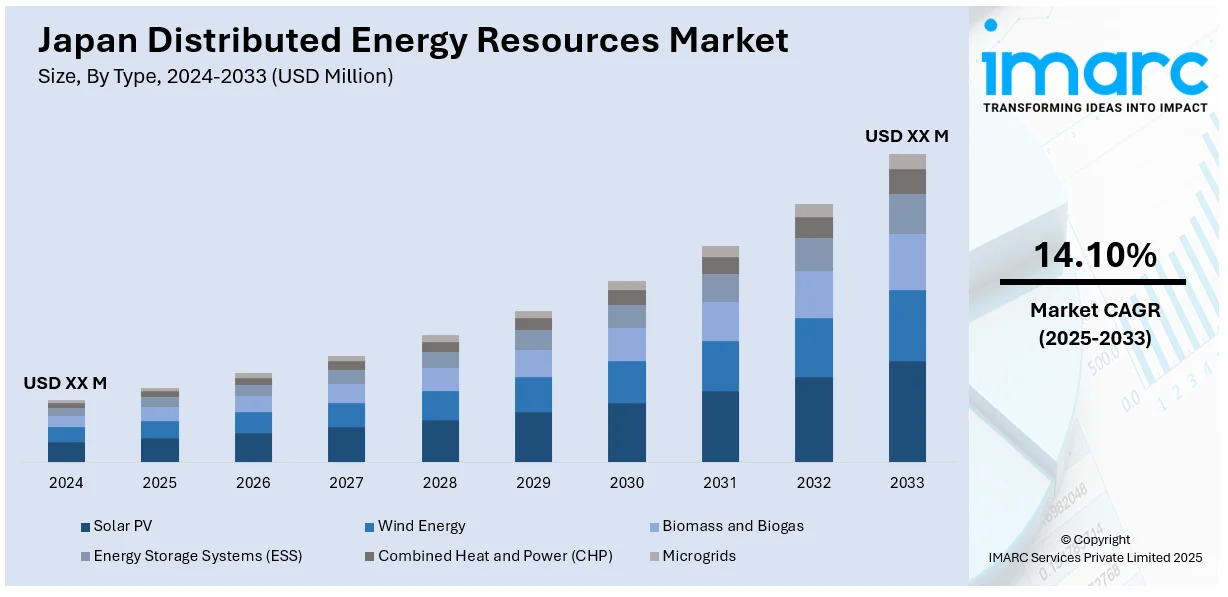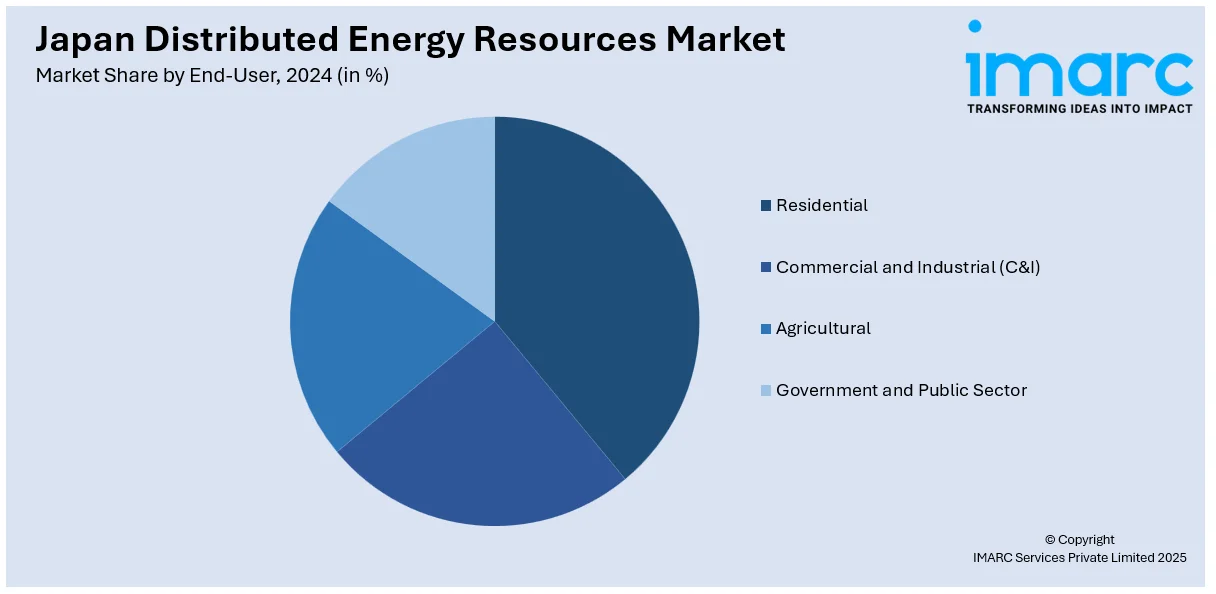
Japan Distributed Energy Resources Market Size, Share, Trends and Forecast by Type, Connectivity, Technology, End-User, and Region, 2025-2033
Japan Distributed Energy Resources Market Overview:
The Japan distributed energy resources market size is projected to exhibit a growth rate (CAGR) of 14.10% during 2025-2033. With the rising adoption of electric vehicles (EVs), the requirement for charging infrastructure is growing, encouraging the setup of local energy systems, including solar panels and battery storage, to aid power stations. Besides this, increasing government expenditure and public-private partnerships in smart city development, which are creating new opportunities for resource deployment, are contributing to the expansion of the Japan distributed energy resources market share.
|
Report Attribute
|
Key Statistics
|
|---|---|
|
Base Year
|
2024
|
|
Forecast Years
|
2025-2033
|
|
Historical Years
|
2019-2024
|
| Market Growth Rate (2025-2033) | 14.10% |
Japan Distributed Energy Resources Market Trends:
Increasing EV production
Rising EV production is positively influencing the market in Japan. As more EVs are entering the market, the demand for charging infrastructure is increasing, leading to the installation of local energy systems like solar panels and battery storage to support charging stations. These systems reduce dependence on the central grid and help manage peak electricity demand. EVs function as portable energy storage systems using vehicle-to-grid (V2G) technology, enabling energy to return to the grid or homes when needed. This strengthens grid stability and promotes efficient energy utilization. Automakers and energy companies in Japan are investing in smart charging solutions, which optimize energy usage by employing distributed energy resources during off-peak hours and when there is plenty of renewable energy available. As EV adoption is rising, it is encouraging the development of microgrids and local energy networks that rely on distributed generation. This integration of EVs with distributed energy resource systems is supporting Japan’s goals of carbon neutrality and energy resilience. It also gives people more control over their energy use, making the system more flexible and sustainable. Consequently, increasing sales of EVs, including electric cars, are enabling the creation of new business models and partnerships that are further accelerating the expansion of distributed energy resource technologies across the country. As per industry reports, the Japan electric car market size is projected to reach 46.97 Billion USD in 2025, and is set to attain 94.51 Billion USD by 2029, growing at a CAGR of 19.10% during the forecast period (2025-2029).

Growing investments in smart city initiatives
Increasing expenditure on smart city initiatives is fueling the Japan distributed energy resources market growth. Smart cities focus on integrating digital technologies with urban infrastructure, which includes renewable energy sources, smart grids, and energy storage systems. These projects often use distributed energy resources like battery storage, rooftop solar panels, and energy management systems to support local energy needs. As cities are aiming to become more resilient and environment friendly, they are wagering on decentralized energy models that reduce carbon emissions and improve energy security. Smart meters, real-time data monitoring, and automated systems assist in more efficiently balancing supply and demand, encouraging the use of local generation and storage. Government funding and public-private partnerships in smart city development are also creating new opportunities for distributed energy resource deployment. In these cities, efficient building systems are connected to energy networks that rely on distributed energy resources to function smoothly. As more smart city projects are emerging across Japan, they are promoting distributed energy resource adoption, making decentralized power a key part of future urban planning and energy strategy. As per the IMARC Group, the Japan smart cities market is set to attain USD 286.6 Billion by 2033, showing a growth rate (CAGR) of 14.6% during 2025-2033.
Japan Distributed Energy Resources Market Segmentation:
IMARC Group provides an analysis of the key trends in each segment of the market, along with forecasts at the country and regional levels for 2025-2033. Our report has categorized the market based on type, connectivity, technology, and end-user.
Type Insights:
- Solar PV
- Wind Energy
- Biomass and Biogas
- Energy Storage Systems (ESS)
- Combined Heat and Power (CHP)
- Microgrids
The report has provided a detailed breakup and analysis of the market based on the type. This includes solar PV, wind energy, biomass and biogas, energy storage systems (ESS), combined heat and power (CHP), and microgrids.
Connectivity Insights:
- On-Grid
- Off-Grid
- Hybrid Systems
A detailed breakup and analysis of the market based on the connectivity have also been provided in the report. This includes on-grid, off-grid, and hybrid systems.
Technology Insights:
- Distributed Generation
- Distributed Storage
- Demand Response Technologies
- Smart Grid and IoT Integration
The report has provided a detailed breakup and analysis of the market based on the technology. This includes distributed generation, distributed storage, demand response technologies, and smart grid and IoT integration.
End-User Insights:

- Residential
- Commercial & Industrial (C and I)
- Agricultural
- Government & Public Sector
A detailed breakup and analysis of the market based on the end-user have also been provided in the report. This includes residential, commercial & industrial (C and I), agricultural, and government & public sector.
Regional Insights:
- Kanto Region
- Kansai/Kinki Region
- Central/ Chubu Region
- Kyushu-Okinawa Region
- Tohoku Region
- Chugoku Region
- Hokkaido Region
- Shikoku Region
The report has also provided a comprehensive analysis of all the major regional markets, which include Kanto Region, Kansai/Kinki Region, Central/Chubu Region, Kyushu-Okinawa Region, Tohoku Region, Chugoku Region, Hokkaido Region, and Shikoku Region.
Competitive Landscape:
The market research report has also provided a comprehensive analysis of the competitive landscape. Competitive analysis such as market structure, key player positioning, top winning strategies, competitive dashboard, and company evaluation quadrant has been covered in the report. Also, detailed profiles of all major companies have been provided.
Japan Distributed Energy Resources Market News:
- In February 2025, Mitsubishi Electric teamed up with HD Renewable Energy to establish a joint venture focused on solar power and battery storage. It aimed to focus on consolidating various distributed energy resources, such as battery storage systems that are owned by HD Renewable Energy in Japan.
Japan Distributed Energy Resources Market Report Coverage:
| Report Features | Details |
|---|---|
| Base Year of the Analysis | 2024 |
| Historical Period | 2019-2024 |
| Forecast Period | 2025-2033 |
| Scope of the Report |
Exploration of Historical Trends and Market Outlook, Industry Catalysts and Challenges, Segment-Wise Historical and Future Market Assessment:
|
| Types Covered | Solar PV, Wind Energy, Biomass and Biogas, Energy Storage Systems (ESS), Combined Heat and Power (CHP), Microgrids |
| Connectivities Covered | On-Grid, Off-Grid, Hybrid Systems |
| Technologies Covered | Distributed Generation, Distributed Storage, Demand Response Technologies, Smart Grid and IoT Integration |
| End-Users Covered | Residential, Commercial & Industrial (C and I), Agricultural, Government & Public Sector |
| Regions Covered | Kanto Region, Kansai/Kinki Region, Central/ Chubu Region, Kyushu-Okinawa Region, Tohoku Region, Chugoku Region, Hokkaido Region, Shikoku Region |
| Customization Scope | 10% Free Customization |
| Post-Sale Analyst Support | 10-12 Weeks |
| Delivery Format | PDF and Excel through Email (We can also provide the editable version of the report in PPT/Word format on special request) |
Key Questions Answered in This Report:
- How has the Japan distributed energy resources market performed so far and how will it perform in the coming years?
- What is the breakup of the Japan distributed energy resources market on the basis of type?
- What is the breakup of the Japan distributed energy resources market on the basis of connectivity?
- What is the breakup of the Japan distributed energy resources market on the basis of technology?
- What is the breakup of the Japan distributed energy resources market on the basis of end-user?
- What is the breakup of the Japan distributed energy resources market on the basis of region?
- What are the various stages in the value chain of the Japan distributed energy resources market?
- What are the key driving factors and challenges in the Japan distributed energy resources market?
- What is the structure of the Japan distributed energy resources market and who are the key players?
- What is the degree of competition in the Japan distributed energy resources market?
Key Benefits for Stakeholders:
- IMARC’s industry report offers a comprehensive quantitative analysis of various market segments, historical and current market trends, market forecasts, and dynamics of the Japan distributed energy resources market from 2019-2033.
- The research report provides the latest information on the market drivers, challenges, and opportunities in the Japan distributed energy resources market.
- Porter's five forces analysis assist stakeholders in assessing the impact of new entrants, competitive rivalry, supplier power, buyer power, and the threat of substitution. It helps stakeholders to analyze the level of competition within the Japan distributed energy resources industry and its attractiveness.
- Competitive landscape allows stakeholders to understand their competitive environment and provides an insight into the current positions of key players in the market.
Need more help?
- Speak to our experienced analysts for insights on the current market scenarios.
- Include additional segments and countries to customize the report as per your requirement.
- Gain an unparalleled competitive advantage in your domain by understanding how to utilize the report and positively impacting your operations and revenue.
- For further assistance, please connect with our analysts.
 Request Customization
Request Customization
 Speak to an Analyst
Speak to an Analyst
 Request Brochure
Request Brochure
 Inquire Before Buying
Inquire Before Buying




.webp)




.webp)












